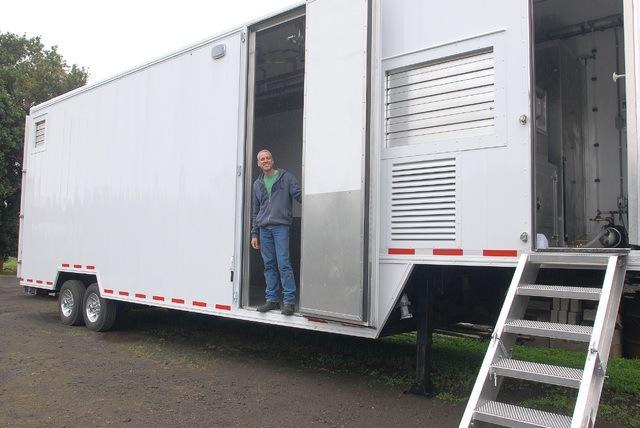Two new meatpacking facilities might open on the Big Island next year following the success of the Hawaii Island Meat Cooperative’s mobile slaughterhouse.
Thanks to the high volume of work carried out at the mobile slaughterhouse, the cooperative is planning the construction of a post-slaughter processing facility on the west side of the Big Island, with a second such facility to open in East Hawaii further in the future, said cooperative president Mike Amado.
The mobile slaughterhouse, one of only about 25 in the country, began operations in April. Since then, it has processed thousands of pounds of livestock.
Amado said the slaughterhouse has processed more than 7,000 pounds of beef, more than 5,000 pounds of pork, more than 1,000 pounds of lamb and sheep meat, and less than 500 pounds of goat meat between April and the end of November.
“It’s about what we anticipated for just the slaughter service,” Amado said. “But we got a lot of demand for post-slaughter services.”
Amado said 21 farms regularly avail themselves of the mobile slaughterhouse’s services, which operates out of a 36-foot-long trailer.
Currently, the cooperative only provides slaughter services, and returns the animal carcasses to their owners to be processed elsewhere. However, the cooperative has long harbored plans to offer chill, cut and wrap services, which, along with the slaughterhouse, would allow the cooperative to process island meat products from pasture to store shelves.
These plans are close to fruition thanks to several grants from Hawaii County’s Department of Research and Development, the U.S. Department of Agriculture’s rural business development program and more. Some of the grants were contingent upon the success of the slaughterhouse unit, Amado said.
Amado said the grants likely will cover nearly all of the construction costs for the first facility, which are estimated between $300,000 and $400,000.
The first facility is planned to be located in Honalo, not far from where the slaughterhouse is stationed in Kealakekua, and work hopefully will commence within six months, Amado said. A location for a matching facility on the east side of the island has not yet been determined.
The mobile slaughterhouse will continue to operate even after the post-slaughter facilities are completed, Amado said.
“It’s a matter of humane treatment,” he said, explaining that one advantage of the mobile unit is that animals are not subjected to stressful long journeys to the slaughterhouse.
However, Amado said the slaughterhouse’s services will not be expanded in the foreseeable future despite some requests to process bison in addition to cattle, sheep, goats and pigs.
“We have more than enough demand right now as it is,” Amado said.
Email Michael Brestovansky at mbrestovansky@hawaiitribune-herald.com.






